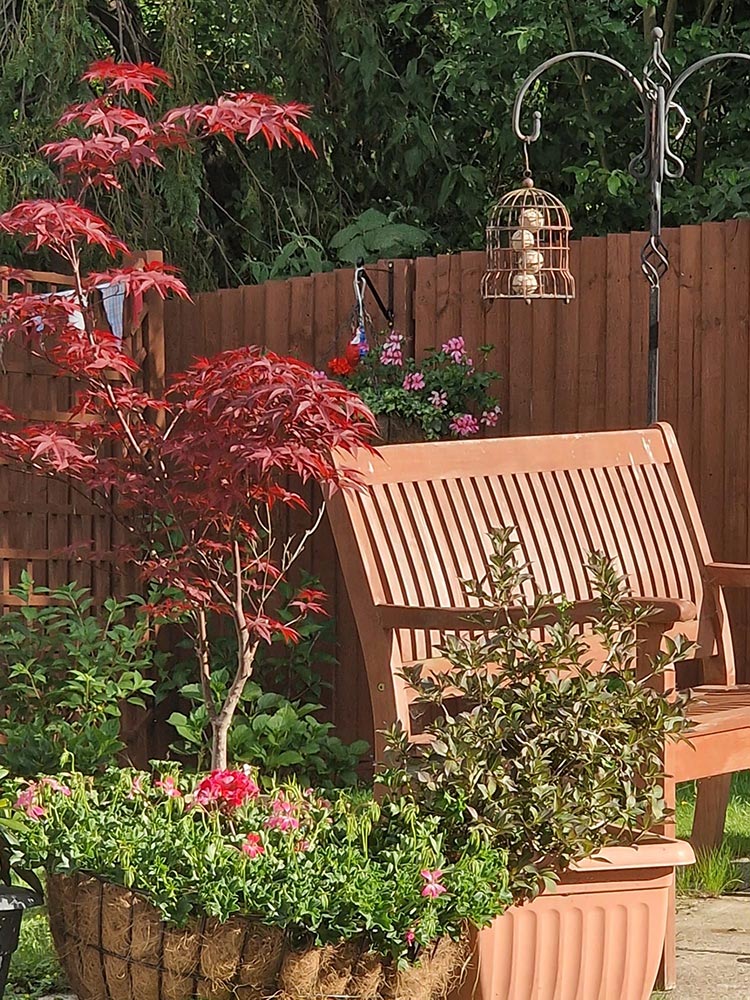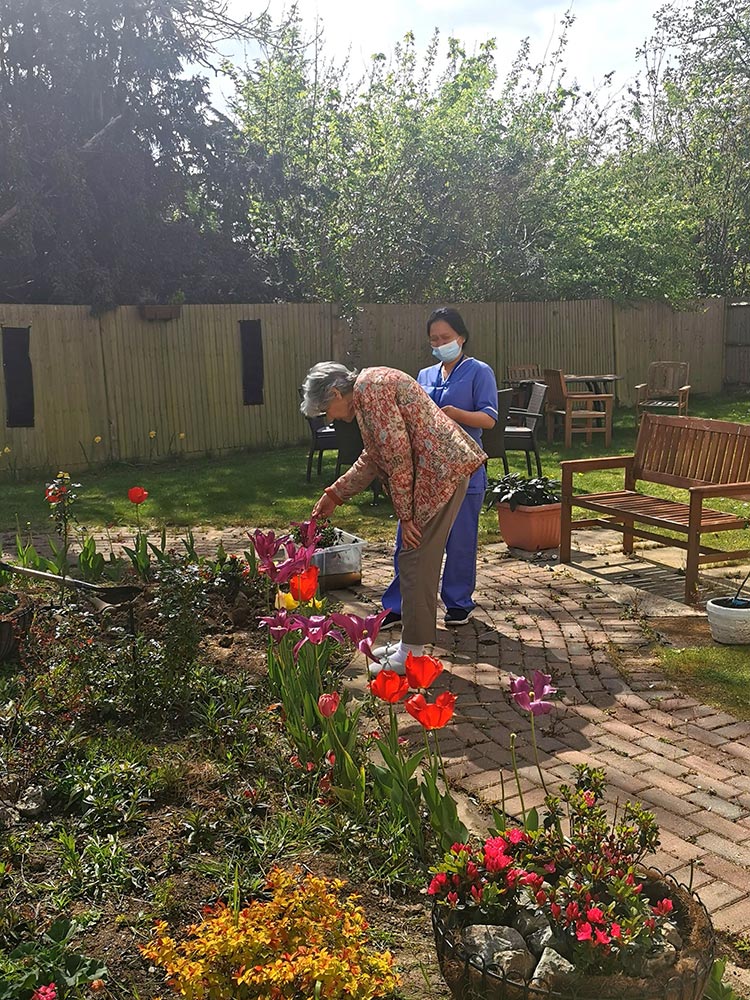Designed to appeal to as many senses as possible, a sensory garden can be a very rewarding place to spend time. A garden should be designed specifically for the users of the environment. For example, if building a sensory space for a school you will want to encourage curiosity and touch, as well as use lots of colours, smells, and tactile features. Children with special educational needs will particularly benefit from being able to explore using multiple senses.
In a healthcare setting such as ours, sensory planting is often designed around the needs of people with dementia. Therefore, calming colours, touch, and scents are encouraged to create a soothing and calming garden for residents and visitors to enjoy time together. Plus, the garden design will need to be geared towards encouraging memory recall and inspiring conversations around distant and nostalgic memories. Aromatic and tactile plants will allow people with a physical impairment, such as sight deterioration or loss, to get up close and personal with nature too, as will growing and sampling homegrown summer salad crops, berries, and herbs. The use of water features and sounds can be soothing and relaxing too.
Creating a sensory garden for individuals with dementia requires careful planning and consideration to provide a safe, comfortable, and stimulating environment for our residents. When creating sensory gardens within our group of care homes, we like to involve the residents in the decision-making process to ensure their ideas and preferences are considered at every step.
Erik Cortez, our Clinical Deputy Manager at Cedar View Care Centre adds:
“Selecting specific plants and features for the sensory garden at Cedar View required meticulous planning and collaboration. Aiming for a vibrant display throughout the year, seasonal plants were thoughtfully chosen with the help of a local gardener and plant seller to ensure perpetual blooming and greenery.
Central to our garden, the water fountain sphere, although a pre-existing feature, underwent necessary repairs to become a functional and aesthetic focal point. We prioritised the inclusion of non-poisonous, scented, and colourful plants, fostering a safe and engaging sensory environment for all our residents to explore and enjoy.
When designing a sensory garden, particularly for individuals with dementia, safety is paramount. Ensuring clear, weed-free pathways is crucial to facilitate easy movement for residents around the garden. In our garden, we focused on creating an environment that not only stimulates the senses but also provides a secure and navigable space for all individuals, regardless of mobility or cognitive ability. Implementing non-toxic plants, clear signage, and secure boundaries also comprised vital aspects of our safety considerations”.

Here is round up of the most important considerations to keep in mind when creating a sensory outdoor area for people with dementia:
How to create a sensory garden
Safety and accessibility
Clear pathways: Ensure that pathways are clear, wide, and free from obstacles to accommodate mobility aids like wheelchairs and walkers. Walkways should allow people to access each of the garden’s sensory aspects, while helping them find seating areas and exits. For people with Alzheimers’ or dementia it is important to stimulate, but not overstimulate. Reducing the risk of confusion and disorientation is crucial.
Non-slip surfaces: Use non-slip materials for pathways to prevent accidents, especially during wet conditions.
Fencing and boundaries: Install fences or natural boundaries to prevent individuals from wandering off. Consider using plants as natural barriers.
Avoid toxic plants: Be mindful of plant selections; avoid toxic plants and ensure that all plants are non-poisonous.
Sensory stimulation
Multisensory elements: Include a variety of sensory elements such as fragrant flowers, wind chimes, textured plants, and bubbling water features.
Contrasting colours: Use contrasting colours to help individuals differentiate between different elements in the garden.
Tactile stimulation: Incorporate plants with interesting textures like lamb’s ear, ferns, or ornamental grasses that are safe to touch.
Aromatic plants: Plant fragrant flowers and herbs like lavender, rosemary, or jasmine to stimulate the sense of smell.
Sensory stations: Create designated areas with different sensory focuses, like a section for touch, another for smell, and another for visual stimulation.
Comfort and relaxation
Seating areas: Provide comfortable seating areas with shade for relaxation. Use chairs with arms to aid in sitting down and standing up.
Shade and shelter: Ensure there are shaded areas to protect individuals from direct sunlight. Consider pergolas, umbrellas, or natural shade from trees.
Water features: Include gentle water features like fountains or small ponds. The sound of running water can have a calming effect. This is very beneficial for anyone experiencing problems with memory impairment.
Comfortable temperature: Plant trees and shrubs strategically to provide natural cooling and windbreaks.

Engaging activities
Raised planters: Use raised planters at different heights to allow residents to engage in gardening activities without the need to bend down. Many of our residents love getting involved with gardening, while others just enjoy spending time outside and socialising with each other.
Bird feeders: Install bird feeders to attract birds, providing both visual and auditory stimulation. The birds and other natural visitors to the garden are always a talking point for our residents and it often helps them to recall special times they have had in their own gardens or with their own pets.
Art installations: Incorporate art or sculptures that are safe and can be touched, encouraging interaction and conversation.
Sensory games: Integrate sensory games like textured tiles on pathways or hidden objects in the garden to encourage exploration. You are never too old to enjoy an easter egg hunt for example, as our residents prove every year!
Familiar and therapeutic elements
Familiar plants: Include plants that residents may have grown or encountered in the past. Familiarity can be reassuring.
Memory corners: Create memory corners with objects or plants that might trigger positive memories, like a variety of heirloom roses.
Therapeutic gardening: Consider areas where residents can participate in therapeutic activities like planting, weeding, or watering plants.
Staff training and involvement
Training: Training staff, caregivers, and family members on how to effectively use the sensory garden for therapy and engagement is important and rewarding because it encourages family and friends to get involved and benefit from the garden experience too.
Regular maintenance: Ensure the garden is well-maintained and seasonally adapted to provide a changing sensory experience throughout the year.
At our Cedar View home, we collaborated with a local gardener and plant seller to create the sensory garden, ensuring not only a convenient source of plants and features but also expert advice and support. The partnership was not only financially beneficial, thanks to the generous discounts provided, but also advantageous in maintaining the lush and orderly state of our garden. The seller not only supplied the plants but also took an active role in planting and ongoing care, including watering and tidying, to uphold the beauty and health of the garden.
By considering these factors, you can create a sensory garden that not only provides comfort and safety but also stimulates the senses and promotes overall wellbeing for individuals with dementia.

Plants for a sensory garden
Enlisting the help of a professional when choosing plants and features for your garden can be a very helpful exercise. Your local garden centre is a great place to start.
We asked Senior Plants Advisor, Mark Reeve, from Coolings Garden Centre in Knockholt, Kent to provide us with some suggestions for plants that would be a perfect choice for sensory gardens:
“Santolina, Brachyglottis, Convolvulus cneorum, Lavandula, Edelweiss, Stipa tenuissima and Thymes such as Woolly Thyme, are all good to brush your hands through. Most herbs are good for scent so again, Thyme is a great choice – there are lots of different types of scented thyme too. Rosemary, Sage, Mint, Lemon Balm, Lemon Verbena, Basil are other wonderful herbs to incorporate.
Be mindful when choosing shrubs as some of the scented ones are toxic – Daphne being one. Buddleja or Osmanthus delavayi would provide scent through the spring and summer. Starting a herb garden is a good starting point. Herbs can thrive in poor soil that’s not too rich but needs to be well-drained. All herbs need a sunny aspect to thrive”.

More information about our Dementia care offering can be found on our website. Alternatively, have a read through our interview with Sue Roberts, who heads quality and compliance at the Future Care Group. Sue’s dementia strategy has already made waves within our homes.
Keep up to date with our latest news & events





